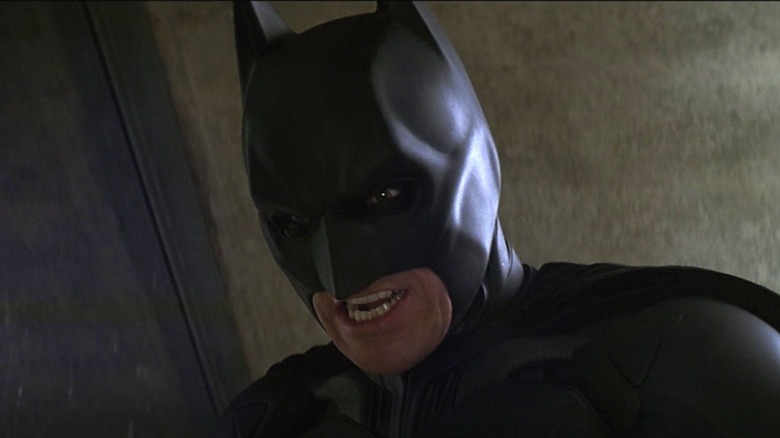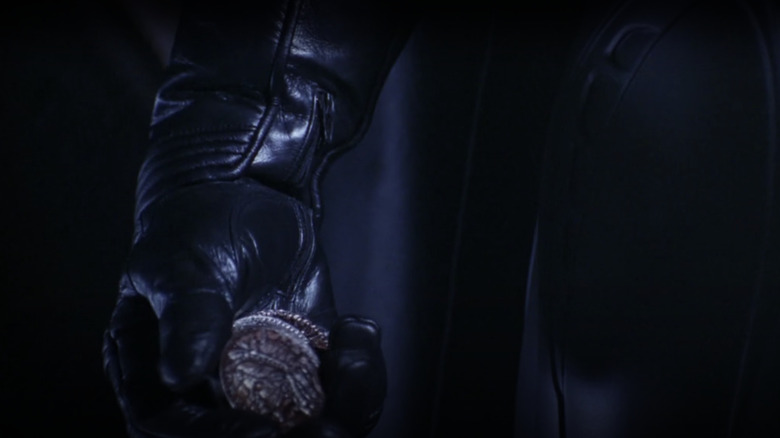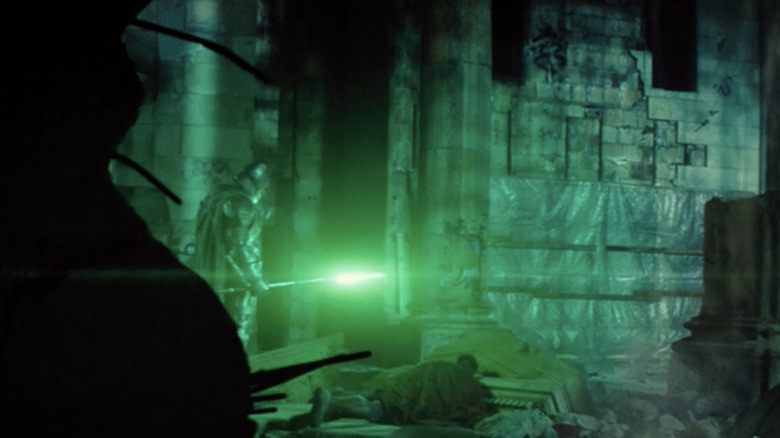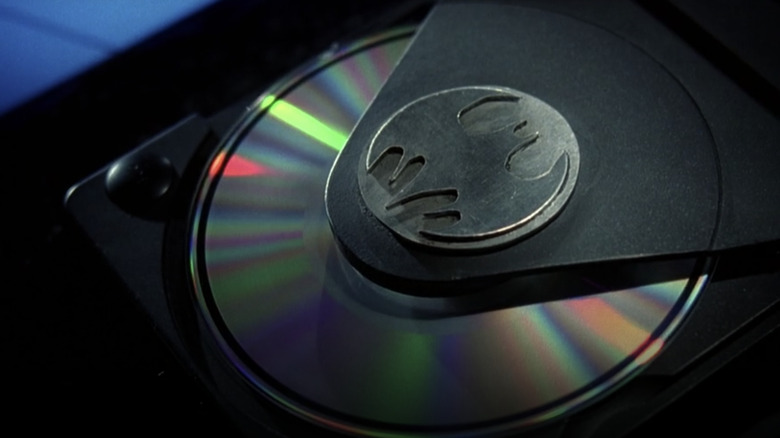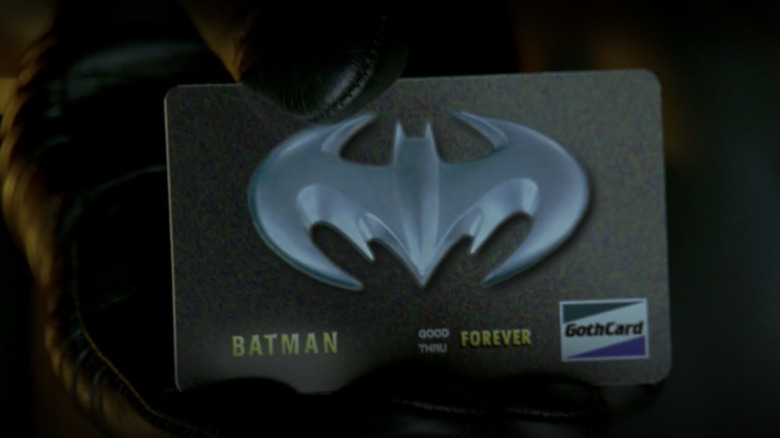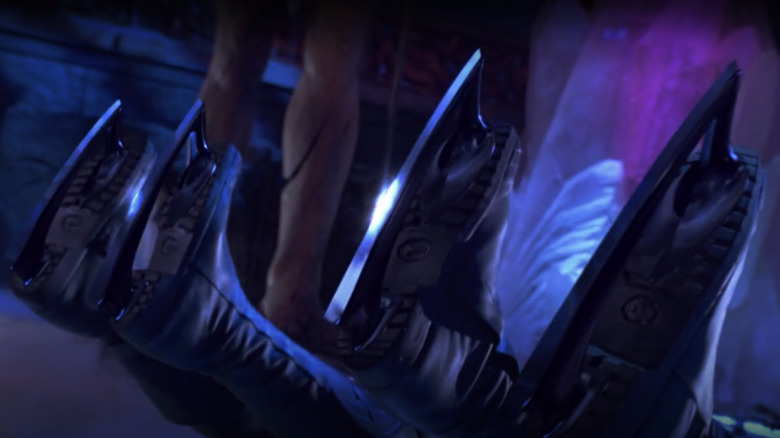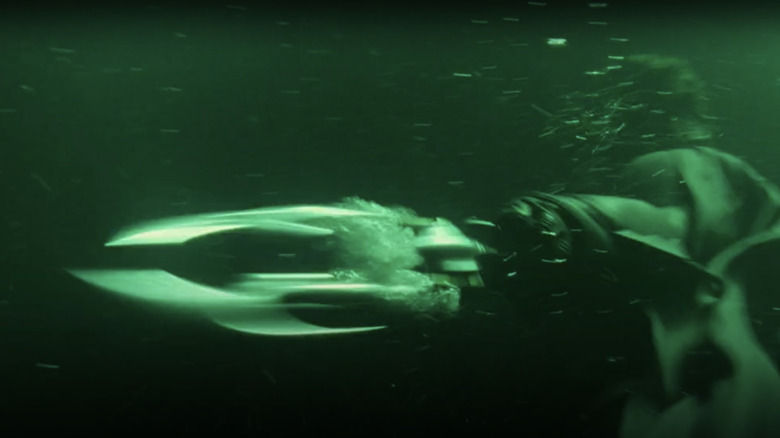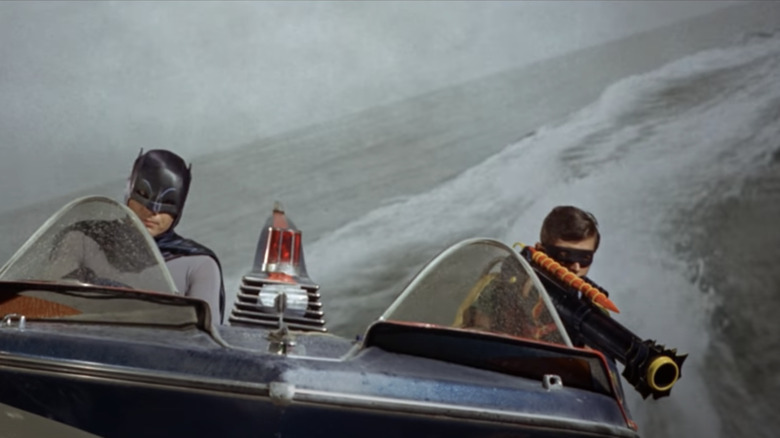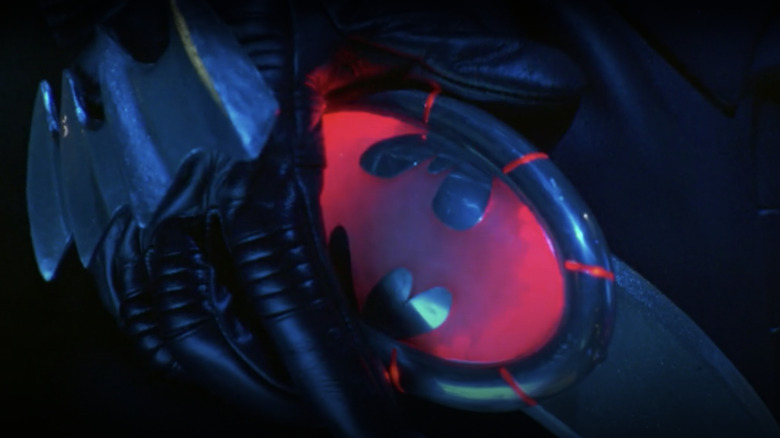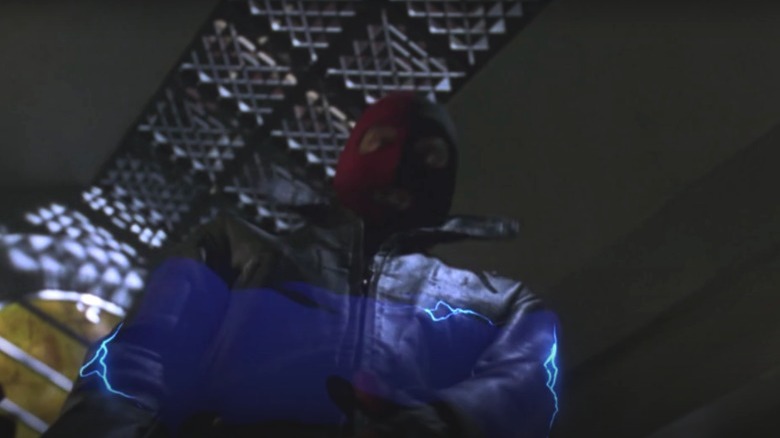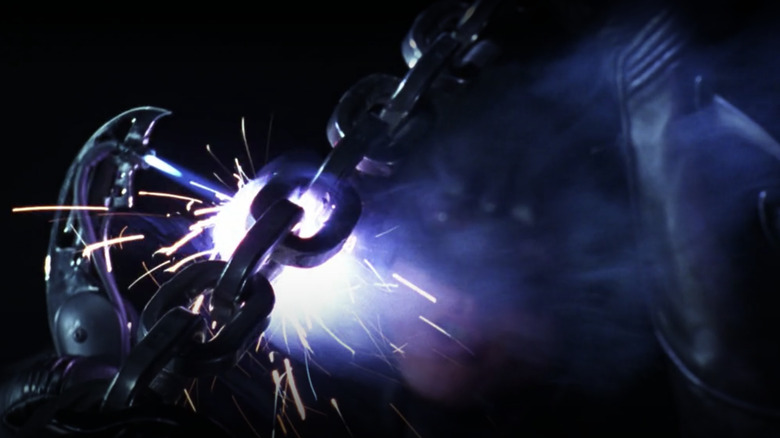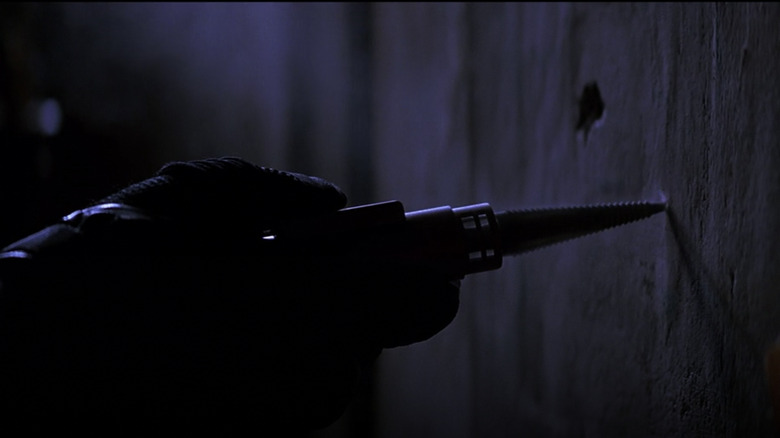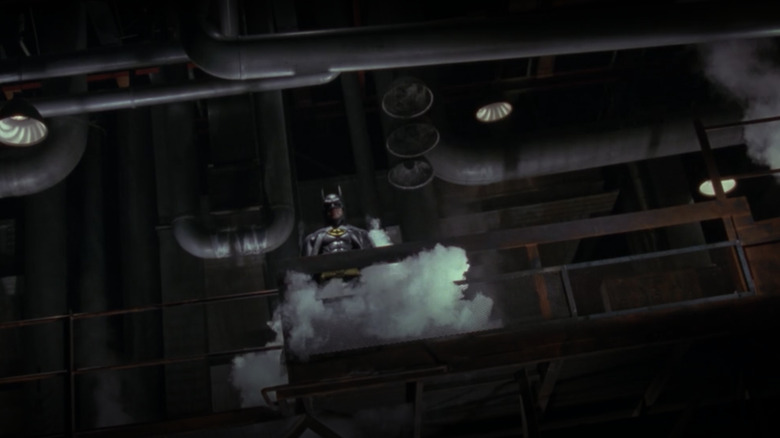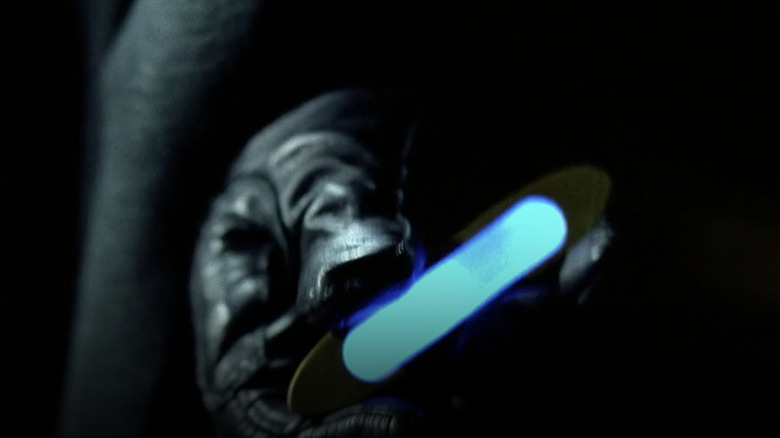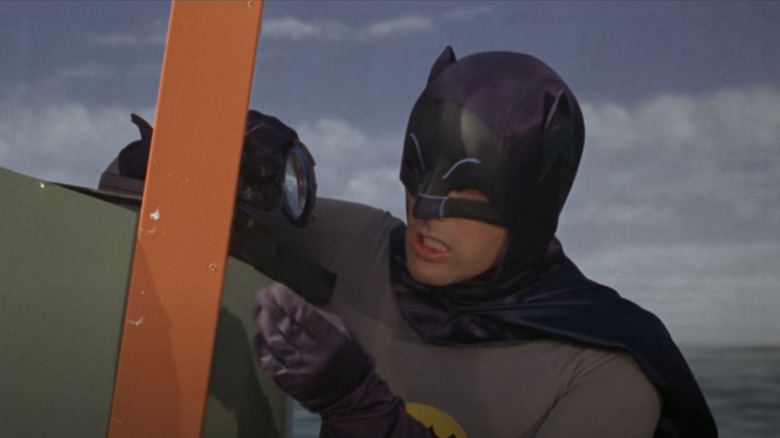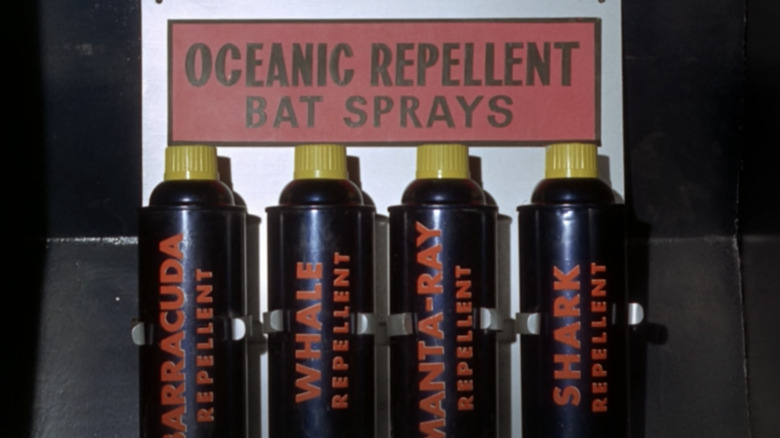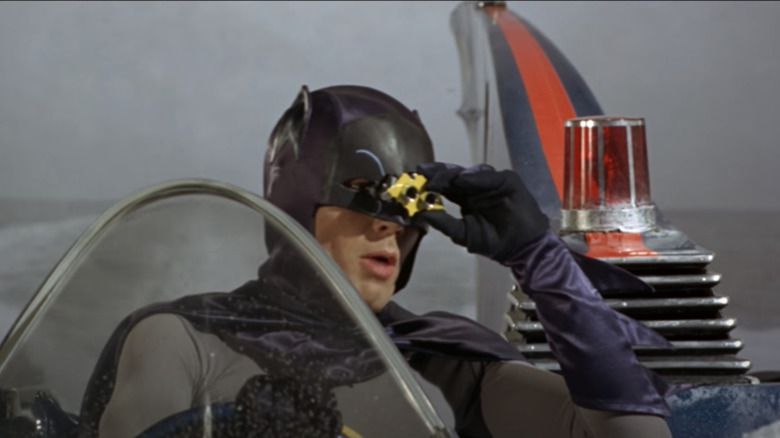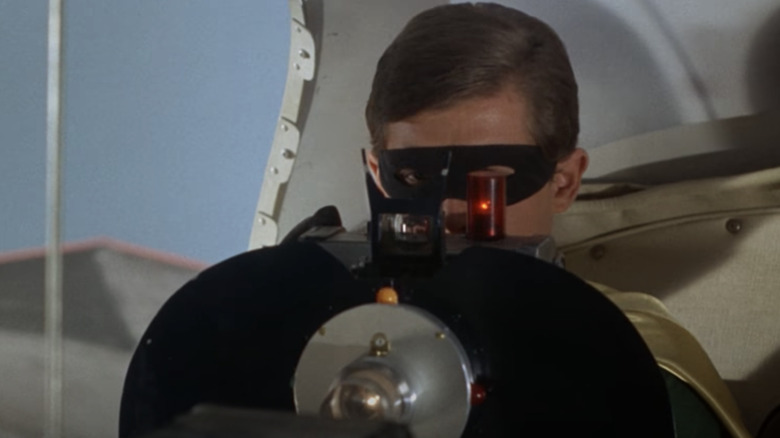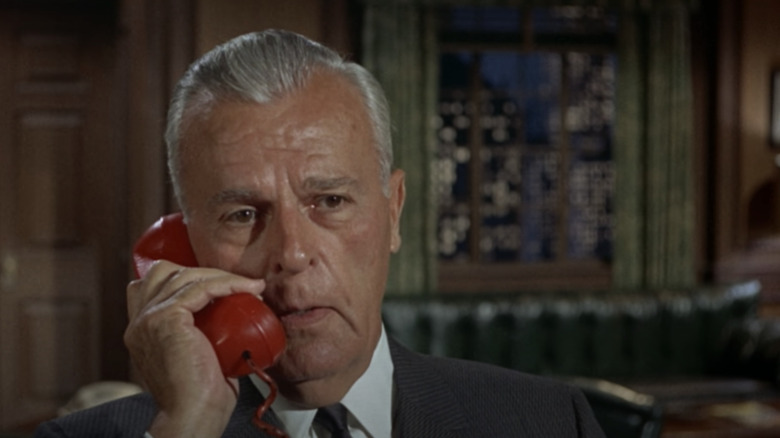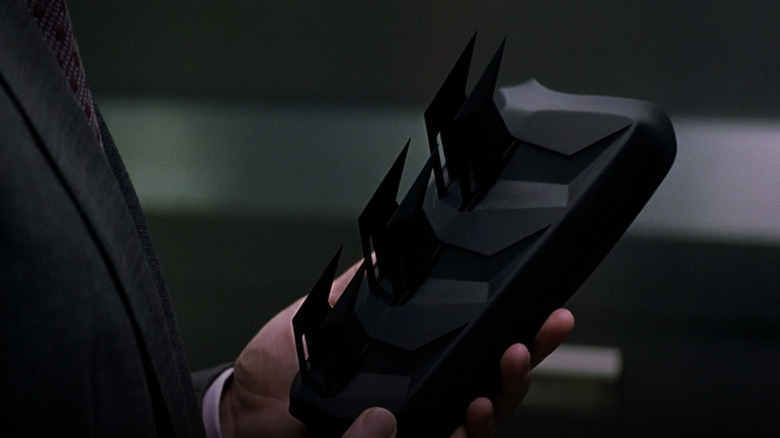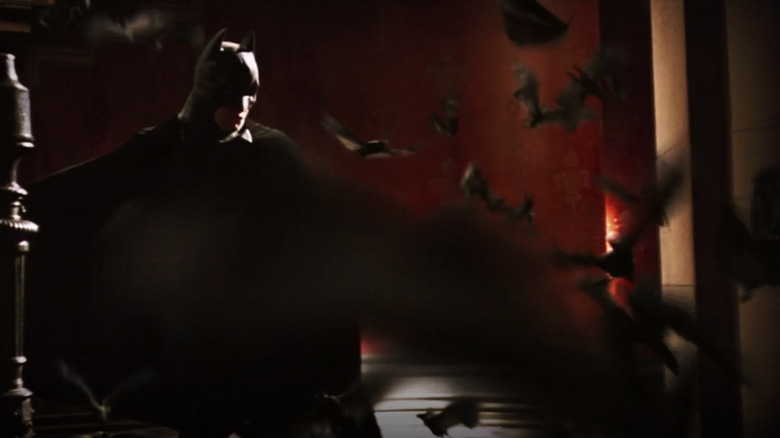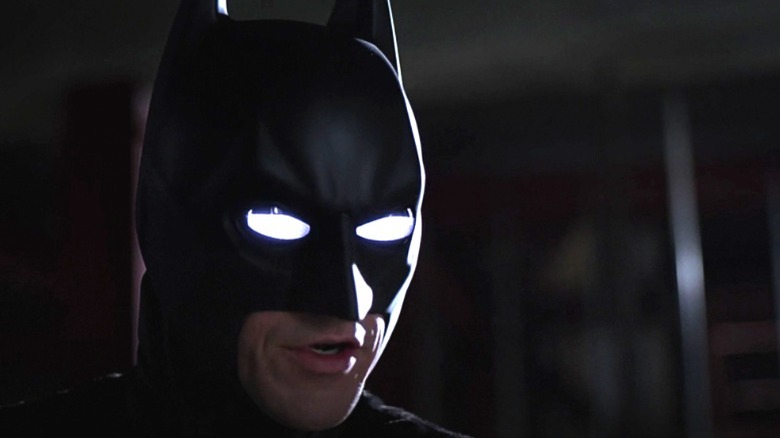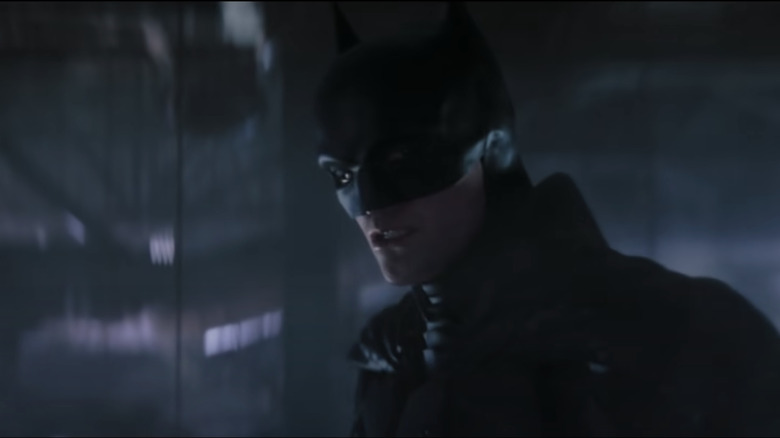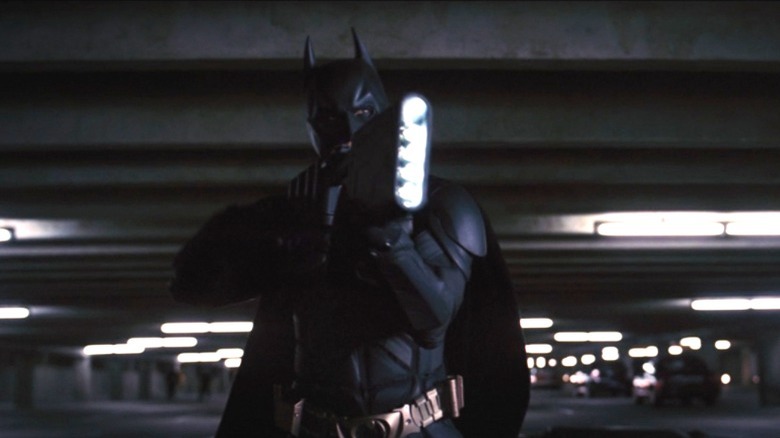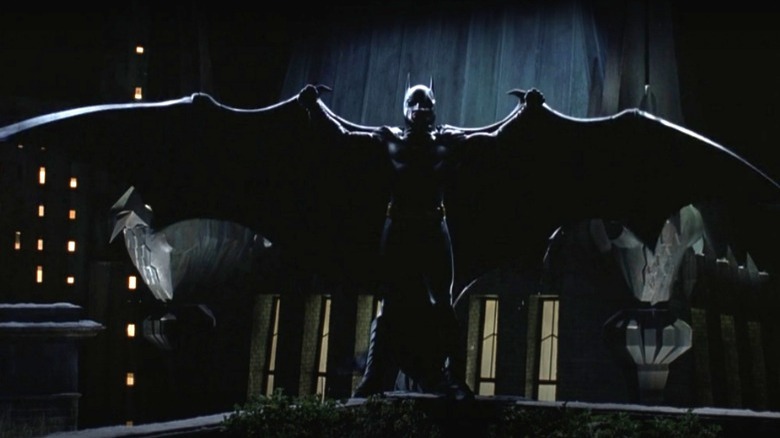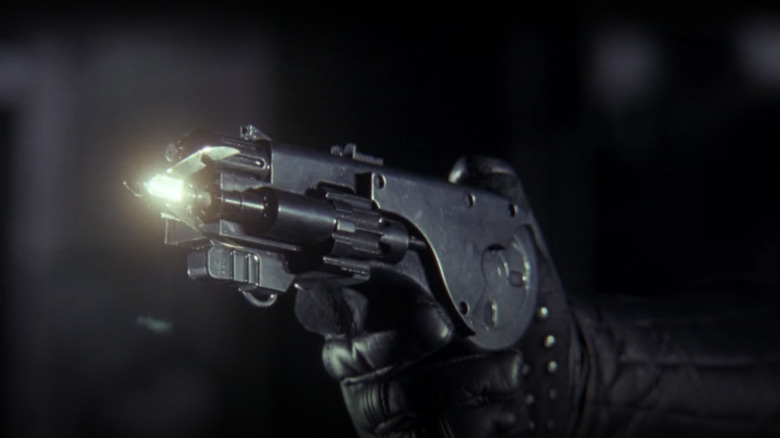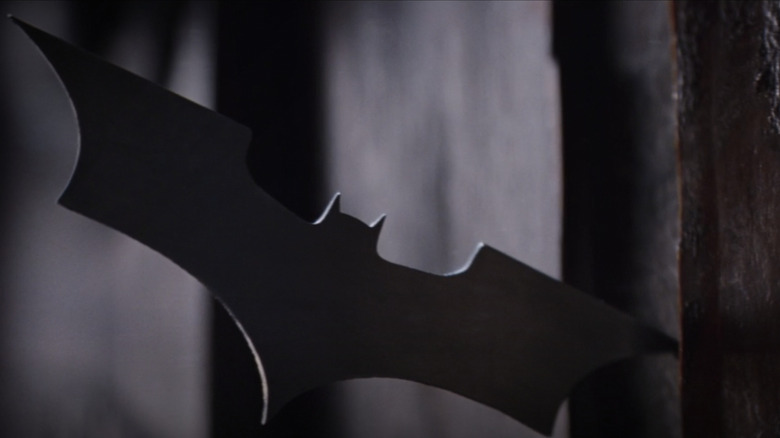Ranking Every Live-Action Batman Movie Gadget From Worst To Best
"Where does he get those wonderful toys?" the Joker (Jack Nicholson) muses to himself in Tim Burton's 1989 megahit "Batman." For decades, the caped crusader has been defined by his wide array of crime-fighting gadgets almost as much as his signature cape and cowl. Just like his fleet of Bat-vehicles, each new Batman film delights in adding new toys to his utility belt. Some are wildly impractical, while others are so practical that they're actually a little boring. When the world of a Batman movie is dark and gritty, his gadgets are likewise blunt and violently effective; when the movie skews a little more campy and whimsical, his gadgets can repel sharks.
With the newest live-action adaptation of the dark knight, Matt Reeves' "The Batman," let's take a look at all of Batman's movie gadgets, ranked from worst to best.
26. Decoy Two-Face coins (Batman Forever)
At the action packed climax of Joel Schumacher's flashy, cartoonish "Batman Forever," Batman (Val Kilmer), Robin (Chris O'Donnell), and Dr. Chase Meridian (Nicole Kidman) are held at gunpoint by Two-Face (Tommy Lee Jones) on The Riddler's (Jim Carrey) island fortress. Formerly Gotham City's district attorney Harvey Dent, Two-Face decides whether to be merciful or murderous by the flip of a two-headed coin. Batman goads Harvey into flipping his coin one last time, pulls a large stack of identical coins from somewhere on his utility belt, and tosses them at Harvey, making the villain lose his balance and fall to a watery grave.
As gadgets go, this one serves its highly specific purpose, but that's just it: Its purpose is very specific. Not only would it not be effective against anyone but Two-Face, it wouldn't be effective against Two-Face in most situations; it all but requires Two-Face to be standing on a precariously high perch where he might become distracted and easily fall. It also raises the question of where, exactly, Batman was carrying those coins on his sleek, notably pocketless utility belt.
25. Kryptonite Spear (Batman v Superman)
Zack Snyder's 2016 sequel "Batman v. Superman: Dawn of Justice" pits the two superhero titans against one another, as Batman (Ben Affleck) blames the destruction of Metropolis and many lives lost at the end of 2013's "Man of Steel" on Superman (Henry Cavill), which, fair enough. To defeat this alien threat to mankind, Batman fashions an array of weapons powered by Superman's Kryptonite, which in his case is actual Kryptonite, including an aerosol spray, a grenade launcher, a suit of armor, and a Kryptonite-tipped spear for the coup de grace.
When the big fight finally happens, most of Batman's Krypto-gadgets work as intended. It is only the coincidence of their mothers having the same name that stops Batman from using the spear for its deadly intent. The two team up alongside Wonder Woman to defeat a different alien threat to mankind, the bony monster Doomsday. In the end, the Kryptonite spear fulfills its promise, as Superman uses it to kill Doomsday, heroically (if temporarily) sacrificing himself in the process.
24. Bat-CD player (Batman Returns)
Tim Burton's 1992 sequel "Batman Returns" has a reputation for being dark and disturbing, a gross-out satire ill-suited for selling McDonalds toys. It is, in fact, all of those things, but it is also surprisingly silly in ways that are now more associated with the campy Schumacher entries. There's Bruce Wayne's (Michael Keaton) deadpan reaction to learning what vichyssoise is, or The Penguin's (Danny DeVito) toy Batmobile, or the Bat CD player.
The CD player is perfectly functional within the plot; Batman has some incriminating audio of The Penguin on a CD and plays it during a public address by the villain, thereby ruining his mayoral campaign. But two things about this particular gadget stand out: One, it is branded with Batman's logo, which raises more questions than it answers; and two, at one point Bruce "scratches" the CD as if he were a DJ with a vinyl record, which is not how a CD works.
23. Bat-Credit Card (Batman & Robin)
So many questions are raised by the blink-and-you'll-miss-it sight gag of the Bat credit card, flashed by Batman (George Clooney) at a charity auction in Joel Schumacher's second and final Bat-film, "Batman & Robin." Why would Gotham City Bank apparently issue Batman his own credit card? What does he buy with this card? Did he have to apply for one? Can anybody apply for one? Does Batman have a separate credit score from Bruce Wayne?
By this fourth entry in the modern day "Batman" franchise, any attempt to ground the films in anything resembling plausible physical or emotional stakes had gone out the window. "Batman & Robin," for better or worse, was bigger, broader, and punnier, more of a sequel to the 1960s TV show than any of its three prequels. That being said, it is a veritable treasure trove of gadgets, as we'll soon see.
22. Bat-Skates (Batman & Robin)
Another entry in the category of implausibly specific Bat-gadget, the retractable ice skates on Batman and Robin's boots in "Batman & Robin" earn points for practicality. When fighting Mr. Freeze's (Arnold Schwarzenegger) hockey-styled henchmen on the ice-covered floor of the Gotham Natural History Museum in the midst of a diamond heist, having a set of blades on you is not the worst idea in the world. And since Batman knew he and Robin were on their way to confront Freeze, we can maybe assume that the Bat-skates were a specific choice on the dynamic duo's part, and not just a part of their costume they carry around all the time, just in case.
21. Bat-Net Gun (Batman Forever)
For an urban superhero whose mascot is a flying mammal, Batman seems to have a lot of nautical adventures in his films, with all the vehicles and gadgets that go along with that. In "Batman Forever," Batman and the newly minted Robin stage a two-pronged raid on The Riddler's island compound via Batplane and Batboat. Robin ejects from the Batboat as it is blown apart by one of The Riddler's undersea mines and is pursued by several harpoon gun-toting henchmen. Batman then comes to his rescue by launching himself out of the Batplane and ensnaring the henchmen in a net fired from a gun. The net gun makes just a brief appearance, never to be used again, but was the perfect weapon for the occasion.
20. Bat-Depth Charges (Batman 1966)
The Dynamic Duo take to the seas for the first time in 1966's "Batman," the feature film spinoff of the popular ABC series. After a cadre of supervillains turns the members of the United World council to dust via a dehydrating machine, Batman (Adam West) and Robin (Burt Ward) attack The Penguin's (Burgess Meredith) submarine lair, forcing it above water with Bat depth charges. Robin fires them from the Batboat via a bazooka-looking device; underwater, we see the charges make impact as bright flashes of colored electricity, as the other villains inside the submarine (Lee Meriwether's Catwoman, Cesar Romero's Joker, and Frank Gorshin as the Riddler) flail about. It's a terribly fun sequence in a film that, despite its campy reputation, shares quite a bit of DNA with darker, more "serious" Bat films to come.
19. Bat-Heaters (Batman & Robin)
Another very specific gadget from "Batman & Robin," the Bat-Heater makes its appearance at the film's climax. Batman, Robin, and newcomer Batgirl (Alicia Silverstone) don new ice-protective costumes to face Mr. Freeze and stop his giant freeze ray from turning Gotham into an ice cube. Part of their arsenal are Bat-logo-shaped heaters that can melt ice within seconds. We see them in action, freeing people whom Freeze has encased in ice. Though they are only deployed in this one instance, a small, portable heater is by far the most practical gadget on the list thus far.
18. Bat-Taser (Batman Forever)
"Batman Forever" starts with a bang, introducing new star Val Kilmer in an action-packed sequence featuring Two-Face and his henchmen, a helicopter, and a bank safe full of acid. Batman takes out Two-Face's gun-toting goons mostly with hand-to-hand combat, but at one point he pulls out what appears to be a Taser-like weapon and fires at one of the henchmen, sending him writhing on the ground, his body visibly coursing with electricity. That alone might seem a little cruel and unusual for Batman, but the fight continues for nearly another minute after that; Batman disarms three more goons, throwing the last one onto the tasered henchman who is apparently still being electrocuted, so that they can get shocked together.
17. Bat-Blowtorch/Laser (Batman Forever, Batman & Robin)
Later in that "Batman Forever" opening sequence, Batman and a bank security guard are stuck atop a large safe being flown through the air, attached to Two-Face's helicopter. Batman fires a grappling hook into a nearby building, attaches it to the safe, then pulls a small blowtorch from his utility belt to sever the chain holding the safe to the helicopter. The chain breaks, and the grappling hook swings the safe back into the hole in the bank wall from whence it came.
"Batman & Robin" does its prequel one better, having Batman carry an actual laser that he uses to thaw Robin after the Boy Wonder is frozen stiff by Mr. Freeze's ice gun. While both tools are fairly practical for Batman's line of work, you might start to wonder how these toys are being powered. The Bat-blowtorch, especially, seems to have no fuel source whatsoever.
16. Bat-Drill (The Dark Knight)
Despite being known in the comics as the World's Greatest Detective, that side of Batman rarely gets its due on film. Christopher Nolan's sequel "The Dark Knight" tries to remedy that in a mid-film sequence that has Batman (Christian Bale) attempt to discover the Joker's (Heath Ledger) identity via a fingerprint on a fired bullet, which lay in pieces within the wall of a crime scene. To get the bullet, Batman removes a chunk of the wall with a small electric drill. It's handy, it's practical, and it's just a little boring as a result. Even when it comes to Batman, they can't all be winners.
15. Smoke Bomb (Batman)
Speaking of not all of them being winners, every so often a Batman film will pull back the curtain of how the caped crusader does his thing. "Batman Begins" made a point of showing the process of how Bruce Wayne became Batman, but other times it makes the character's magic dim just a little bit. Take the moment in the 1989 "Batman," after Batman has aided the police in a shootout with gangster Jack Napier and his goons at Axis Chemicals. With cops approaching on either side of him, Batman throws down a smoke bomb and uses that as cover to escape upward via grappling gun. There's nothing terribly interesting about it, and even its practicality is blunted by the fact that Commissioner Gordon (Pat Hingle) and his officers can clearly see Batman escaping through the smoke.
14. Bat-'Napalm' (Batman Returns)
Like his taser weapon in "Batman Forever," the skin-burning liquid that Batman throws at Catwoman (Michelle Pfeiffer) in "Batman Returns” seems to be toeing the line of his usually non-fatal weaponry. Then again, this is also a film where Batman sets one member of The Penguin's circus gang on fire with the Batmobile and seemingly blows another one up with dynamite. The film never quite explains what the liquid is; Catwoman later complains that Batman "napalmed [her] arm," though it is unlikely to be actual napalm. The injury leaves a large bumpy scar on Catwoman's arm, humorously exposed during Selina Kyle and Bruce Wayne's makeout scene, where the two keep inadvertently finding each other's superhero injuries.
13. Bat-Detective Kit (Batman 1966)
If nothing else, Adam West's Batman knew the value of branding. Even the most prosaic tool of the superhero's trade can be made special with a Bat-prefix on its name, an insignia, and perhaps a bat-shaped redesign. The briefly seen Bat Detective Kit in the 1966 "Batman" has all three. At its core, the detective kit is no great shakes: A medium-sized briefcase, a magnifying glass, and a screwdriver are all we see of it as Batman and Robin scour a booby-trapped buoy for evidence. But that briefcase has the Bat-logo stamped on it, that magnifying glass is shaped like Batman's cowl, and the screwdriver is pretty much a screwdriver, albeit colored blue and yellow. That's how a not-terribly-interesting gadget is elevated to a staple of the Dark Knight's arsenal.
12. Bat-Sprays (Batman 1966)
Early in the 1966 "Batman" the search for a missing yacht leads to Batman being attacked by a dynamite-filled shark. To repel the animal, there is but one solution: The shark-repellent Bat spray that they just happened to have in the Batcopter, alongside repellent Bat sprays for several other aquatic threats. It's a fine gag, but as a practical gadget, it's pretty limited.
Luckily, the dynamic duo have more gasses on hand. Later in the film they use both an aerosol knock-out gas and a wake-up gas on The Penguin, who at the time is pretending to be the missing Commodore who Batman and Robin are searching for. They also have an antidote for the knock-out gas, in case The Penguin might want to knock them out and steal the Batmobile, which he very much does.
11. Bat-Binoculars (various)
Even at his most dark and serious, Batman's look is pretty flamboyant. Nevertheless, a fair amount of the detective part of his job involves snooping around places, often with the aid of binoculars. Batman has rocked a number of looking glasses over the years, with varying styles and tactical advantages. In the 1966 movie and on the TV series, Batman utilizes possibly the world's smallest pair of binoculars, which might actually be the most advantageous of any of them, as he can reasonably fit them into his utility belt. During the "Knightmare" sequence in "Batman v Superman," Batman is seen in his desert gear using a pretty ordinary pair of binoculars.
In "Batman Begins," however, he makes a few odd choices. First, he uses a periscope instead of binoculars, which, fine. But then he gives the periscope to a young fan (played by future "Game of Thrones" tyrant Jack Gleeson) so that the boy can prove to his friends that he saw Batman. That's a nice gesture, but considering that Batman is set on fire by The Scarecrow (Cillian Murphy) just minutes later, perhaps he should have held onto his surveillance equipment.
10. Bat-Cameras (Various)
Speaking of surveillance, it's a little surprising how rarely Batman uses cameras in his crimefighting. Usually it's people trying to take pictures of him, such as Kim Basinger's Vicky Vale in the 1989 film, and not the other way around. There are, however, two notable appearances of a Bat-Camera. The first is in the 1966 film when Batman and Robin head out in the Batcopter to track down Commodore Schmidlapp's missing yacht. Robin photographs the yacht with a very elaborate and cool looking Bat-shaped camera, just as it disappears into nothing.
The next notable Bat camera wouldn't come onto the scene for nearly another 60 years. In 2022's "The Batman," the Dark Knight (Robert Pattinson) wears surveillance camera contact lenses that record what he sees at crime scenes for review. Later in the film, he lends his lenses to Catwoman (Zoe Kravitz) as she does reconnaissance work at The Penguin's (Colin Farrell) underworld nightclub.
9. Bat-Phone (Batman 1966)
Batman films traffic in a lot of sci-fi adjacent technology, from rocket-powered Batmobiles to lasers to alien meteorite weaponry. When it comes to his communication devices, though, the world has pretty much caught up with whatever the films have presented as super advanced tech. In "Batman Returns," he essentially Skypes with Alfred (Michael Gough) in the Batmobile via a dashboard monitor. In "Batman Forever," Bruce talks to Alfred through what is more or less a smartwatch. In "Batman Begins," he just uses a walkie-talkie.
If the technology isn't impressive, then it had better be distinctive and cool. That is why Batman's greatest communication device is, and arguably always will be, his first: The Bat-Phone, the 1966 glowing red rotary-style landline that connects stately Wayne Manor to Commissioner Gordon's (Neil Hamilton) office. Gordon keeps his under protective glass, while Bruce keeps his out in the middle of his study, where literally anyone could happen upon it and start asking questions. There have been many Batmobiles and Batsuits over the decades, but there has yet to be a better, or even another Bat-Phone.
8. Bat-Gauntlets (Various)
While Batman's forearm gauntlets are not always gadgets, those times when he adds a little something extra to them are always special. In the 1989 film he uses, a brace that pops out from his gauntlet to stop a flying kick in midair, and early in "The Dark Knight," he wears a mechanical apparatus that gives him the strength to bend a rifle barrel and tear open a car door.
"Batman Begins" establishes that the blades on his gauntlet are defensive, inspired by the ninja uniform he wore while honing his skills with the sinister League of Shadows. When his costume is redesigned in "The Dark Knight," those blades become offensive, able to be launched from his forearms — an upgrade that comes in handy in his climactic fight with The Joker. The gauntlets in "The Batman" are likewise tactical, if lacking the same emotional significance and payoff.
7. Bats (Various)
"They're great survivors," Batman tells Vicky Vale about the bats she sees all around his cave in 1989's "Batman." The caped crusader has been surrounding himself with his namesake for a long time, and has even used the animals in his hero work. In "Batman Returns," he sics a small flock of bats onto The Penguin," and in "Batman Begins," he uses a sonar device to call every bat in Gotham to cover his escape from Arkham Asylum. "What's that noise?" Jim Gordon (Gary Oldman) asks as the squeaking swarm approaches. "Backup," Batman growls.
The downside of having such a recognizable trademark, however, is that it can be used against you. The bat attack on The Penguin at the end of "Batman Returns" is poetic justice for the villain's earlier attempt to frame Batman for the murder of a beauty queen by releasing a huge swarm of bats from the Gotham City Christmas tree.
6. Bat-Sonar (The Dark Knight)
A sonar-equipped Batsuit makes an appearance at the end of "Batman Forever," though its actual sonar abilities are ill-defined. The franchise's real application of bat-like echolocation comes in "The Dark Knight." Batman's gadget master Lucius Fox (Morgan Freeman) develops a technology that can turn any cell phone into a sonar device, creating a map of its immediate vicinity. Batman uses this when he travels to Hong Kong in order to extradite a mob accountant (Chin Han).
Things take a darker turn when Batman utilizes Fox's technology to turn every phone in Gotham into a sonar device, giving him a panoramic view of the entire city at all times. Lucius is aghast at the development, and only agrees to help Batman in order to track down The Joker. His loyalty is rewarded when the device self-destructs after The Joker is captured, but it won't be the last time that a Batman movie would delve into the dicey waters of vigilante ethics.
5. Bat-Venom (The Batman)
The human cost of being a superhero is very much on the mind of Matt Reeves' "The Batman," which features a weakened and exhausted Batman turning to some sort of green injectable chemical in order to rejuvenate himself. The drug works, and gives him bursts of strength and agility, but with it comes terrible rages and mood swings, as when he nearly beats a man to death while under its influence.
Though it is never explicitly referred to as such, the drug bears a strong resemblance to strength-enhancing narcotic Venom. Though Venom is most associated with Batman supervillain Bane, it was actually introduced by writer Dennis O'Neil in the pages of "Legends of the Dark Knight" in 1991, with Batman as its first user and abuser. Like the Christopher Nolan films O'Neil's "Venom" story arc, "The Batman" takes a hard look at its hero's methods of fighting crime and ponders just how far is too far.
4. EMP Rifle (The Dark Knight Rises)
It's a rare Batman gadget that is both tactical and atmospheric, something that can strike fear into the hearts of villains while also actually striking them. In "The Dark Knight Rises," Bruce Wayne once again dons the cape and cowl after nearly a decade in seclusion, drawn out by the fearsome terrorist Bane (Tom Hardy) and class-conscious thief Catwoman (Anne Hathaway). The film's first action sequence is its best, as Batman takes to the streets and then the air in his flashy new flying vehicle (simply called The Bat). But before The Bat makes its big entrance, the Dark Knight shows off a new, even cooler toy: A rifle that emits an electromagnetic pulse, shorting out anything running on electricity for a short moment.
Batman joins the scene in midstream, as Gotham police pursue Bane's henchmen through a tunnel. Suddenly, the lights of the tunnel go dark and car engines stall as a black figure whips by. A veteran Gotham City cop (Brent Briscoe) smiles and tells his young partner, "You are in for a show tonight, son."
3. Bat Cape (Various)
Like his gauntlets, Batman's cape is mostly decorative, a dramatic flourish that gives weight and significance to every move the Dark Knight makes. But sometimes it can do more than just look good. At worst, it can be a pretty ill-defined gadget, as in "Batman Forever" when Batman uses the cape as a kind of heat shield to save him from an explosion. At its best, though, it can fulfill the promise of its bat-wing shape and let the Caped Crusader take to the sky.
"Batman Returns" turns its cape into a hang glider for one scene, but "Batman Begins" makes it a core of Batman's abilities. Lucius Fox patiently explains to Bruce (and the audience) how the cape's materials can actually harden into a specific shape when given an electric charge, turning Batman into a fearsome flying monster — not just to the criminals he hunts, but to the fear-stricken citizens of Gotham. It's a reminder that living in a city with a Batman running around would probably be pretty scary.
2. Grappling Gun (Various)
The grappling gun is a key piece of Batman's cinematic arsenal — almost the key piece. Nearly every version of Batman on film has used it to zip around Gotham City, and in many ways its design and function will mirror the film itself. The grappling gun in the 1989 film shares Batman's black and gold color scheme, and its curved barrel echoes Anton Furst's Gothic-meets-Art-Deco production design. The Schumacher films' grappling guns grew progressively ornate and unreal looking.
The grappling gun of "Batman Begins" looks like modern tactical tech, with pains taken to make it seem like a thing that could exist in real life, while Ben Affleck's grappling gun in "Batman v Superman" is needlessly bulky. The grappling gun in "The Batman" snaps out from Batman's arm, a la Travis Bickle's gun sleeve in "Taxi Driver," a key influence on the film as a whole. When Batman needs to scale a building, make a quick yet mysterious exit, or snare a goon by the throat, the grappling gun is there for him.
1. Batarang (Various)
Adam West's Batman doesn't use a grappling gun, though. When he needs to scale the outside of a building, he uses his Batarang. When Michael Keaton needs to take out four circus goons (and a poodle) at the same time, he uses his Batarang. When Val Kilmer needs to destroy The Riddler's mind control device, he uses his Batarang. When Christian Bale needs to knock out the lights at the Gotham shipyards to stage a sneak attack on Carmine Falcone's henchmen, he uses his Batarang.
Like Batman himself, the Batarang has countless variations, yet is always recognizably itself. It can be so high tech that it acts like a flying drone, as in "Batman Returns," or little more than a sharply angled piece of metal, as in "Batman Begins." It is Batman's signature tool and weapon, designed in his own image, endlessly versatile, and maybe the only thing in his inventory that is highly unlikely to get destroyed in every movie.
